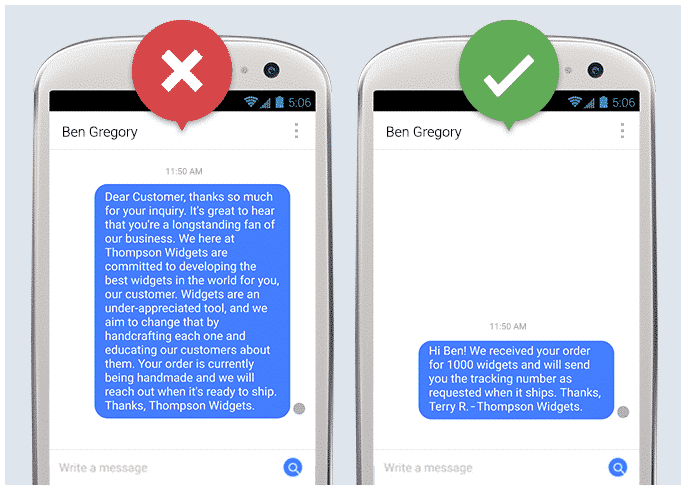In the second part of this series, we will provide you with 7 more Facebook Messenger Etiquette Mistakes that your brand should avoid.
Let’s check it out!
4. Using sarcasm or irony
Using sarcasm and irony on social media may be harmful. How many times have you seen individuals misinterpret and take offense at a tongue-in-cheek remark?
In case you’re not communicating straightforwardly, you might never know you’ve lost somebody’s business (or any hope of getting it).
Can edgier brands get away with a bit of more attitude? Not on Facebook Messenger. If somebody is reaching out with a question or suggestion, a snarky comment suggests you’re not taking the individual or their concerns seriously.
5. Messaging too frequently
On March 4, Facebook changed its 24-hour response policy. Businesses now have 24 hours to send messages (by human or bot) in response to certain consumer actions, with no further responses allowed afterward.
Consumer actions that start the 24-hour countdown include:
- Sending a message to a brand page
- Clicking a call-to-action-button within a Messenger conversation
- Clicking on a Click-to-Messenger advert and beginning a conversation
- Beginning a conversation with the brand page via a plugin
- Reacting to a message
However, regardless of how or why a consumer reaches out to you, it’s not an invitation to flood their inbox. Limit your response(s), and make sure they’re relevant to the initial message.
After the initial 24-hour period, you may send event reminders and order and account updates using streamlined message tags. You may also send sponsored messages to re-engage customers and prospects.
Order status updates are always appreciated. So is the occasional flash sale. However, don’t inundate individuals with offers. Too many Facebook Messenger notifications will eat up brand equity fast.
6. Sending sloppy, error-filled messages
Nothing says “uncaring” like a poorly written message. Friends could forgive grammar, punctuation, and spelling errors, however, customers and prospects won’t cut you any slack.
Before you hit “send,” take a minute to check for typos, missing words, misplaced punctuation, and so on. Try tightening up the language. Ensure you’ve covered all the bases in your response. The individual on the receiving end will appreciate the effort.
7. Writing long paragraphs
Think of the last time you looked for a simple answer however encountered an enormous wall of text instead. You had to comb through to seek out what you needed. Frustrating, right?
The last thing you need to do is give your customers and prospects the same experience.
Source: Facebook for business
Maintain your messages on point and easy to digest by limiting them to two or three short sentences. If the consumer’s question or drawback is more complex, you might need to continue the conversation on another channel (phone, email, or live chat).
8. Letting bots do all the work
A Facebook Messenger bot could be a nice business tool. However, most of Facebook’s 6 million advertisers aren’t seizing the opportunity. At this time, there are only 300,000 active Messenger bots.
Bots can acknowledge customers’ messages, collect input, and reply to basic questions. They will also complete simple tasks—every little thing from checking flight statuses to recommending products.
You should use quick replies, for instance, to ask for a consumer’s product preferences or contact information. Once the consumer gives the requested information, that action prompts a new message, and the fast reply request disappears.
Source: Facebook for developers
Here are Original Coast Clothing’s quick replies in action:
Source: Facebook for developers
Don’t rely too heavily on bots, or you’ll irritate customers who prefer to deal with real people. If a question or problem is too complicated for bots to deal with, they need to “know” to stand down. If a live person isn’t available to connect, direct customers to a different channel so they can get the help they want.
To learn more about the way to create Facebook bots and how leading brands are using them, take a look at our complete guide to using Facebook Messenger bots for business.
9. Forwarding a message to a third party
Individuals use Facebook Messenger, rather than posting on a brand’s Facebook page because the platform is personal. Forwarding a person’s messages to a third party would be perceived as a breach of trust.
If you need to involve a third party to escalate a customer support problem, for instance, you need to ask for express permission to forward the message thread. Otherwise, provide a phone number and/or email address the customer can use to connect with the third party directly.
10. Not saying goodbye
In case you assume a Facebook Messenger conversation has ended and you fall silent without saying goodbye, you can leave the consumer feeling neglected or snubbed. This wouldn’t be searched for your brand or a smart move for your business.
It’s essential to deliver closure to every exchange. Always ask some questions like “Is there anything else I can help you with today?” You’ll never know what other loyalty-building or sales-driving opportunities await.




